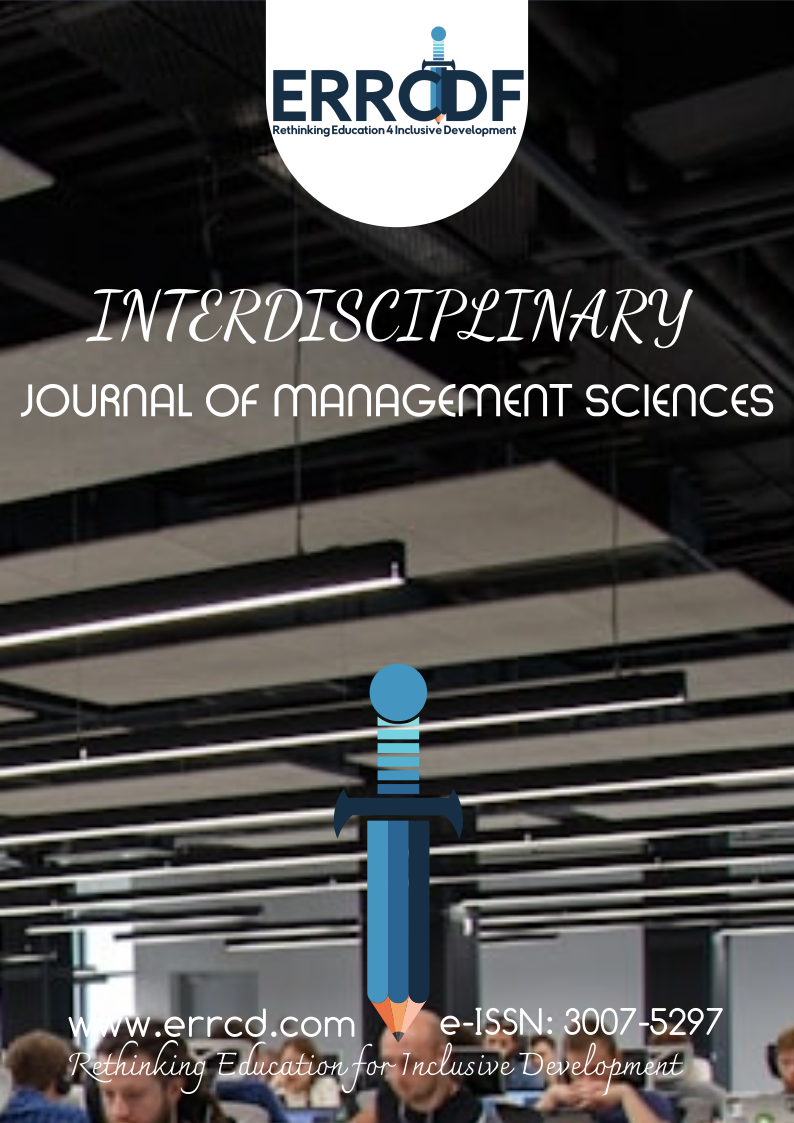Banking crises and government interventions: Mapping the evolution of response mechanisms and scholarly discourse (1979–2025)
DOI:
https://doi.org/10.38140/ijms-2025.vol2.2.04Keywords:
Banking crises, government interventions, bibliometric analysis, Basel reforms, financial governance, digital finance , digital currenciesAbstract
Banking crises have been intrinsic to the development of the global financial system, prompting governments to implement increasingly complex and responsive interventions. Since the U.S. savings and loan crisis of the 1980s, as well as the Global Financial Crisis of 2008 and the COVID-19 pandemic, institutional fragilities have been exposed to successive systemic shocks, leading to policy responses such as bailouts, recapitalisations, Basel regulatory reforms, and digital finance projects. Nevertheless, despite the extensive scholarly work on the subject, no systematic bibliometric reconstruction of the theorisation and criticism of government interventions has been undertaken. This paper addresses that gap by tracing the intellectual trajectory of research on banking crises and interventions from 1979 to 2025. Based on 1,148 Scopus-indexed records narrowed down to 580 high-quality publications, the bibliometric analysis, utilising VOSviewer and Publish or Perish, reveals three phases of evolution of the discourse: Institutionalist stability, macroeconomic crisis management, and digital resilience are essential topics. This research contributes to methodological pluralism and cross-regional integration, which are important avenues for overcoming the conceptual and geographical fragmentation that has persisted in the field.
References
Abascal, R., & González, F. (2019). Shareholder protection and bank executive compensation after the global financial crisis. Journal of Financial Stability, 40, 15–37. https://doi.org/10.1016/j.jfs.2018.11.004
Al Husaeni, D. F., & Nandiyanto, A. B. D. (2021). Bibliometric using Vosviewer with Publish or Perish (using Google Scholar data): From step-by-step processing for users to the practical examples in the analysis of digital learning articles in pre- and post-COVID-19 pandemic. ASEAN Journal of Science and Engineering, 2(1), 19–46. https://doi.org/10.17509/ajse.v2i1.37368
Basmar, E., Campbell, C. M., & Fachmi, M. (2024). The green economy crisis turbulence and the reaction of finance distribution in Indonesian banking. International Journal of Sustainable Development and Planning, 19(11), 4239–4250. https://doi.org/10.18280/ijsdp.191113
Bayazitova, D., & Shivdasani, A. (2012). Assessing TARP. Review of Financial Studies, 25(2), 377–407. https://doi.org/10.1093/rfs/hhr121
Bank for International Settlements. (2011). Basel III: A global regulatory framework for more resilient banks and banking systems. https://www.bis.org/publ/bcbs189.pdf
Bocola, L. (2016). The pass-through of sovereign risk. Journal of Political Economy, 124(4), 879–881. https://doi.org/10.1086/686734
Braverman, A., & Guasch, J. L. (1986). Rural credit markets and institutions in developing countries: Lessons for policy analysis from practice and modern theory. World Development, 14(10–11), 1253–1267. https://doi.org/10.1016/0305-750X(86)90104-X
Brimble, M., Stewart, J., & de Zwaan, L. (2010). Climate change and financial regulation: Challenges for the financial sector following the global financial crisis. Griffith Law Review, 19(1), 71–85. https://doi.org/10.1080/10854669.2010.10854669
Burnham, J. F. (2006). Scopus database: A review. Biomedical Digital Libraries, 3(1). https://doi.org/10.1186/1742-5581-3-1
Byl, L., Carson, J., Feltracco, A., Gooch, S., Gordon, S., Kenyon, T., Muirhead, B., Seskar-Hencic, D., MacDonald, K., Özsu, M. T., & Stirling, P. (2016). Measuring research output through bibliometrics.https://doi.org/10.13140/RG.2.1.3302.5680
De Bruyckere, V., Gerhardt, M., Schepens, G., & Vander Vennet, R. (2013). Bank/sovereign risk spillovers in the European debt crisis. Journal of Banking and Finance, 37(12), 4793–4809. https://doi.org/10.1016/j.jbankfin.2013.08.012
Diamond, D. W., & Rajan, R. G. (2005). Liquidity shortages and banking crises. Journal of Finance, 60(2), 615–647. https://doi.org/10.1111/j.1540-6261.2005.00741.x
Dong, Y., Meng, C., Firth, M., & Hou, W. (2014). Ownership structure and risk-taking: Comparative evidence from private and state-controlled banks in China. International Review of Financial Analysis, 36, 120–130. https://doi.org/10.1016/j.irfa.2014.03.009
Dugbartey, A. N. (2025). Systemic financial risks in an era of geopolitical tensions, climate change, and technological disruptions: Predictive analytics, stress testing and crisis response strategies. International Journal of Science and Research Archive, 14(2), 1428–1448. https://doi.org/10.30574/ijsra.2025.14.2.0563
Farihah, E., Hartadinata, O. S., Robani, A., & Yuliawan, R. (2024). Assessing banks’ performance in sustainability practices and programs during the COVID-19 pandemic: The case of Indonesian banks. Global Business and Finance Review, 29(6), 31–46. Scopus. https://doi.org/10.17549/gbfr.2024.29.6.31
Flannery, M. J., Kwan, S. H., & Nimalendran, M. (2013). The 2007-2009 financial crisis and bank opaqueness. Journal of Financial Intermediation, 22(1), 55–84. https://doi.org/10.1016/j.jfi.2012.08.001
Gabor, D. (2016). The (impossible) repo trinity: The political economy of repo markets. Review of International Political Economy, 23(6), 967–1000. https://doi.org/10.1080/09692290.2016.1207699
Gabor, D., & Brooks, S. (2017). The digital revolution in financial inclusion: International development in the fintech era. New Political Economy, 22(4), 423–436. https://doi.org/10.1080/13563467.2017.1259298
Gabor, D., & Jessop, B. (2014). Mark my words: Discursive central banking in crisis. In Financial cultures and crisis dynamics (pp. 294-314). Routledge.
García-Herrero, A., Gavilá, S., & Santabárbara, D. (2009). What explains the low profitability of Chinese banks? Journal of Banking and Finance, 33(11), 2080–2092. https://doi.org/10.1016/j.jbankfin.2009.05.005
Greenbaum, S. I., & Thakor, A. V. (1987). Bank funding modes: Securitization versus deposits. Journal of Banking and Finance, 11(3), 379–401. https://doi.org/10.1016/0378-4266(87)90040-9
Harrington, S. E. (2009). The financial crisis, systemic risk, and the future of insurance regulation. Journal of Risk and Insurance, 76(4), 785–819. https://doi.org/10.1111/j.1539-6975.2009.01330.x
Haw, I. M., Ho, S. S. M., Hu, B., & Wu, D. (2010). Concentrated control, institutions, and banking sector: An international study. Journal of Banking and Finance, 34(3), 485–497. https://doi.org/10.1016/j.jbankfin.2009.08.013
Kenton, W., & Kelly, R. C. (2024). Savings and loan crisis (S&L): What happened and aftermath. Investopedia. https://www.investopedia.com/terms/s/sl-crisis.asp
Kizito, Z. (2025). The role of central bank digital currencies (CBDCs) in monetary policy transmission. International Journal of Economic Policy, 5(3), 46–60. https://doi.org/10.47941/ijecop.2989
Martin, E. (2020). Europe’s ‘historic’ deal and the future of the EU. Gisreportsonline. https://www.gisreportsonline.com/r/debt-mutualization/
McKibbin, W., & Fernando, R. (2023). The global economic impacts of the COVID-19 pandemic. Economic Modelling, 129, 106551. https://doi.org/10.1016/j.econmod.2023.106551
Min, H. (2019). Blockchain technology for enhancing supply chain resilience. Business Horizons, 62(1), 35–45. https://doi.org/10.1016/j.bushor.2018.08.012
Passas, I. (2024). Bibliometric analysis: The main steps. Encyclopedia, 4(2), 1014–1025. https://doi.org/10.3390/encyclopedia4020065
Pisani-Ferry, J., & Sapir, A. (2010). Banking crisis management in the EU: An early assessment. Economic Policy, 25(62), 341–373. https://doi.org/10.1111/j.1468-0327.2010.00243.x
Potters, C., & Velasquez, V. (2024). What is the CARES Act? Investopedia. https://www.investopedia.com/coronavirus-aid-relief-and-economic-security-cares-act-4800707
Radelet, S., & Sachs, J. (2000). The onset of the East Asian financial crisis. In NBER Chapters (pp. 105–153). https://www.nber.org/system/files/chapters/c8691/c8691.pdf
Riding, A. L., & Haines, G. Jr. (2001). Loan guarantees: Costs of default and benefits to small firms. Journal of Business Venturing, 16(6), 595–612. https://doi.org/10.1016/S0883-9026(00)00050-1
Simpson, O. (2004). The impact on retention of interventions to support distance learning students. Open Learning, 19(1), 79–95. https://doi.org/10.1080/0268051042000177863
Smallbone, D., & Welter, F. (2001). The role of government in SME development in transition economies. International Small Business Journal, 19(4), 63–77. https://doi.org/10.1177/0266242601194004
Tian, Y. (2024). Analysis of the impact of US quantitative easing policy on China’s macro economy. Highlights in Business, Economics and Management, 24, 2069–2084. https://doi.org/10.54097/2zjt2679
Veronesi, P., & Zingales, L. (2010). Paulson’s gift. Journal of Financial Economics, 97(3), 339–368. https://doi.org/10.1016/j.jfineco.2010.03.011
Wang, L., Tong, X., & Wang, Y. X. R. (2022). Statistics in everyone’s backyard: An impact study via citation network analysis. Patterns, 3(8), 100532. https://doi.org/10.1016/j.patter.2022.100532
Zyoud, T. R. K. B., & Dr. M. M. (2024). Quantitative research methods: Maximising benefits, addressing limitations, and advancing methodological frontiers. Journal of Multidisciplinary Studies, 11–14. https://doi.org/10.5281/ZENODO.10939470
Downloads
Published
How to Cite
Issue
Section
License
Copyright (c) 2025 John Akwetey Boafo, Noble Osei-Poku Danzerl, Kwesi Peprah Amoafo-Danquah, Efua Odurah Maclean, Gifty Akuffo

This work is licensed under a Creative Commons Attribution 4.0 International License.







